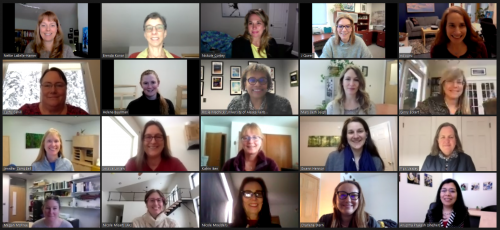Friday Focus: Tearing down obstacles
March 4, 2021
— by Nettie La Belle-Hamer, interim vice chancellor for research
What do agile software development and diversity in STEM have in common? The success
of each depends on the constant removal of obstacles.
The agile method revolutionized the software development world by moving completely
away from the traditional method, called waterfall. In waterfall, you start at the
top-level concept and fully design, document, and vet each conceptual level adding
more detail. The code is not even started until all the documentation is completed,
which can take years for large projects. Sounds good as it will have been fully designed, except while you are working on this detailed documentation, the technology
is moving forward and your design, when it is finally complete, is antiquated before
you even start building the code.
Imagine instead you try each idea as they come. You can integrate new technology as
it evolves, include new ideas as they unfold, and the end product will embrace modern
ideas, technology, and evolving customer needs. Central to this form of development
is the “scrum master” (yep, they are really called that), a skilled coder who removes
the obstacles for the team daily. This daily attention to removing what is blocking progress creates a development
velocity that cannot be achieved otherwise. For those trained in waterfall, agile
can feel scary and uncomfortable with so many unknowns. For those trained in agile,
waterfall can feel like trying to code with your hands tied behind your back while
stalled, waiting for obstacles to move. What has this to do with increasing the underrepresented in STEM fields? It struck
me like a lightning bolt while reading Dr. Rita Colwell’s book, “A Lab of One’s Own.”
As a member of an underrepresented population, I have never lacked internal drive
to be a scientist nor the intelligence to be successful at it. I have, however, had
to muster energy and strength — repeatedly — to overcome the many obstacles thrown
at me. As someone with many battle wounds, I understand when not everyone wants to
continue the fight. Imagine how many more success stories we would have if women were
not told that they are “wasting their time in a field they could never be successful
in” or that fellowships are “not to be wasted on women”!
What has this to do with increasing the underrepresented in STEM fields? It struck
me like a lightning bolt while reading Dr. Rita Colwell’s book, “A Lab of One’s Own.”
As a member of an underrepresented population, I have never lacked internal drive
to be a scientist nor the intelligence to be successful at it. I have, however, had
to muster energy and strength — repeatedly — to overcome the many obstacles thrown
at me. As someone with many battle wounds, I understand when not everyone wants to
continue the fight. Imagine how many more success stories we would have if women were
not told that they are “wasting their time in a field they could never be successful
in” or that fellowships are “not to be wasted on women”!
Vice Chancellor Champagne’s article in the Feb. 19 issue of Cornerstone reminds us that Black history is American history. Likewise, women’s history is American history. You could insert any of the underrepresented populations in STEM
into that sentence and I will guarantee that you will find their stories missing from
the mainstream history of our nation. We have been here all along and deserve to have
our stories told.
To increase diversity in STEM fields and academic leadership, we need to stop thinking
that the problem lies in lack of drive, intellect or interest of the underrepresented.
We don’t need pink Legos to get women to want to be engineers — they already do and always have. We need to recognize that by removing the obstacles to success, diversity will naturally
increase. My interest in science came from, well, my interest in science! No one needed
to persuade me that it is a fascinating career from me. But, I did run into a lot
of obstacles: teachers who pulled me aside to tell me that it is not natural for me
to be so good at math, peers who told me that I was taking a place in the physics
program that rightfully belonged to a man, and faculty who openly stated that I should
go home to take care of my family. I needed a personal scrum master, clearing my path
of obstacles!
The removal of obstacles cannot be one and done — it needs to be continual and universal.
We have figured out how to make elegant code quickly, now we need to apply those concepts
to building diversity into STEM leadership.
As the vice chancellor for research, I am focused on working hard to remove obstacles
to your success in research. While not everything can be fixed today, I will do what
I can to help us achieve our goals. I need your help identifying those obstacles most
in need of demolition.
Think of me as UAF’s scrum master, ready to remove obstacles to increase our research
velocity. Moving forward, it is up to us.
Thank you for choosing UAF.
Friday Focus is a column written by a different member of UAF’s leadership team every
week. On occasion, a guest writer is invited to contribute a column.


